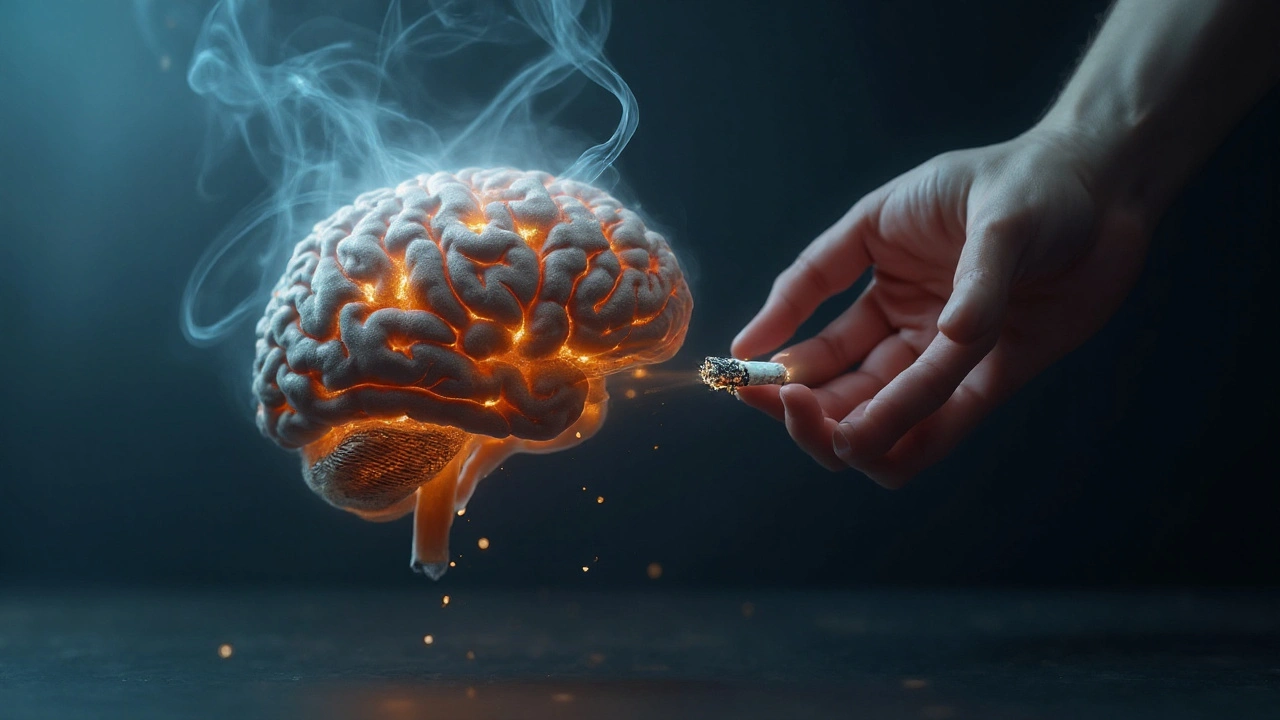
Smoking Addiction is a chronic, relapsing condition driven by nicotine's impact on the brain's reward circuitry. It blends chemical dependence with learned habits, making the decision to quit feel like climbing a steep hill while the body screams for a puff.
How Nicotine Hijacks the Brain
Nicotine is a potent alkaloid that activates nicotinic acetylcholine receptors, flooding the brain with dopamine. This surge creates a fleeting sense of pleasure, which the brain quickly learns to chase.
Within seconds of inhalation, nicotine reaches the bloodstream and crosses the blood‑brain barrier. The rapid delivery is why cigarettes feel more addictive than slower‑acting nicotine products.
The Role of Dopamine and the Reward Pathway
Dopamine is a neurotransmitter that signals reward and motivates repeat behavior. Each cigarette spikes dopamine levels by up to 300%, reinforcing the smoking habit.
Over time, the brain recalibrates: normal activities produce less dopamine, while smoking becomes the primary source of pleasure. This shift explains why non‑smokers can enjoy a coffee, but a smoker feels an emptiness without a cigarette.
Cravings, Cue‑Induced Relapse, and the Power of Triggers
Craving is a strong, often sudden desire to smoke, triggered by environmental cues or emotional states. Common triggers include coffee, stress, or a break at work.
Research from the University of Auckland (2023) showed that smokers who associate a specific routine with smoking are 40% more likely to relapse after a quit attempt. The brain stores these cue‑memory links in the hippocampus, so even a glimpse of a cigarette pack can spark a craving.
Cue‑Induced Relapse refers to the phenomenon where external cues prompt a return to smoking after a period of abstinence. It’s why many people fail on “the first stressful day” after quitting.
Withdrawal Symptoms and Psychological Barriers
Withdrawal is a cluster of physical and mental symptoms that appear when nicotine levels drop, including irritability, anxiety, difficulty concentrating, and insomnia.
According to a 2022 New Zealand Health Survey, 68% of quitters report intense irritability during the first week, and 45% say mood swings keep them from staying smoke‑free beyond two weeks.
These symptoms are not just discomfort; they signal the brain’s attempt to restore its previous equilibrium. The psychological component-feeling “out of control” or fearing weight gain-adds a layer of resistance that pure pharmacology can’t fully address.

Self‑Efficacy, Motivation, and the Mindset Shift
Self‑Efficacy is a person’s belief in their ability to execute actions required for a specific outcome. High self‑efficacy predicts better quit rates.
When smokers doubt their capacity to resist cravings, stress hormones rise, and the odds of relapse climb. Conversely, setting realistic milestones-like “no cigarettes after lunch for one week”-boosts confidence and reduces perceived difficulty.
Motivational Interviewing is a client‑centered counseling technique that strengthens personal motivation for change. It helps smokers articulate their own reasons for quitting, making the goal feel self‑driven rather than imposed.
Evidence‑Based Interventions
Several approaches combine pharmacology and behavior change. Below is a quick comparison of the most common options.
| Strategy | Mechanism | Typical Success Rate (12‑month) | Typical Duration | Common Side Effects |
|---|---|---|---|---|
| Nicotine Replacement Therapy | Delivers controlled nicotine doses to reduce withdrawal | ≈25% | 8‑12 weeks | irritation, sleep disturbance |
| Varenicline (Chantix) | Partial nicotine receptor agonist, blunts cravings | ≈30‑35% | 12 weeks (often 24 with taper) | Nausea, vivid dreams |
| Behavioural Therapy | Addresses triggers, builds coping skills | ≈20‑25% (higher when combined with meds) | 6‑12 sessions | None (time commitment) |
Combining a medication with behavioural support consistently outperforms either method alone. The key is matching the strategy to the smoker’s personal triggers and lifestyle.
Practical Tips to Strengthen Your Quit Attempt
- Identify your top three cues (e.g., coffee, after meals, stress) and replace them with a non‑smoking habit such as a short walk or a sip of water.
- Use a quit‑date app to track cravings; research shows that logging each urge reduces its intensity by 15% on average.
- Seek out a peer support group-either in‑person or online. Shared stories lower feelings of isolation and boost self‑efficacy.
- Consider a short‑term nicotine patch to smooth the first week of withdrawal, then switch to a behavioural plan that focuses on cue management.
- Practice deep‑breathing or mindfulness for 5 minutes when a craving hits; this activates the prefrontal cortex, helping you override the automatic response.
Related Concepts and Next Steps
The psychology of Conditioned Reinforcement explains why certain environments become linked with smoking, while Stress‑Induced Relapse highlights the role of cortisol spikes in triggering urges.
For readers wanting to dive deeper, explore topics such as the genetic predisposition to nicotine dependence, the impact of e‑cigarettes on brain chemistry, and long‑term health outcomes after quitting.

Frequently Asked Questions
Why do cravings feel stronger after the first week?
During the first week, nicotine levels drop sharply, and the brain’s reward system is still recalibrating. This physiological dip, combined with learned cue associations, makes urges feel unusually intense.
Can I quit without medication?
Yes, many succeed using purely behavioural methods, especially when they have strong self‑efficacy and a solid support network. However, success rates rise when a short‑term medication eases withdrawal symptoms.
What role does stress play in relapse?
Stress triggers cortisol release, which can amplify craving intensity. Managing stress through exercise, mindfulness, or counseling reduces the likelihood of a slip.
Is vaping a safer way to quit?
While e‑cigarettes deliver nicotine without many of the combustion toxins, they still maintain the behavioural hand‑to‑mouth habit and can perpetuate dependence. Current health agencies recommend approved cessation aids over vaping.
How long does withdrawal typically last?
Physical symptoms peak around 3‑5 days and fade within 2‑4 weeks. Psychological cravings can linger for months, especially when triggered by familiar cues.




20 Comments
Quitting smoking feels like trying to climb a steep hill while the wind keeps pushing you back.
Our brains are wired to chase the dopamine rush that nicotine provides, and that chase becomes a habit that wraps itself around every daily ritual.
When you light a cigarette with your morning coffee, the brain links the two, making the coffee feel incomplete without the smoke.
The reward system rewires itself, so even activities that used to be enjoyable lose their sparkle.
Withdrawal symptoms such as irritability and anxiety are the brain’s protest against the sudden loss of that artificial pleasure.
These symptoms aren’t just fleeting; they can linger for weeks, creating a constant battle of willpower.
Because the habit is both chemical and behavioral, breaking it requires more than just will; it needs a new set of cues to replace the old ones.
One effective strategy is to identify your top three triggers and swap them with a healthier habit, like a short walk or a sip of water.
Using a quit‑date app to log cravings can actually lower their intensity, as the act of recording makes the urge feel less magical.
Support groups, whether online or in‑person, provide social reinforcement and remind you that you’re not alone in this fight.
Pharmacological aids like nicotine patches or varenicline can smooth the physical side of withdrawal, giving your brain a gentler transition.
But even the best medication won’t work if you keep placing yourself in the same stressful situations without new coping tools.
Mindfulness and deep‑breathing exercises engage the prefrontal cortex, helping you override the automatic response to reach for a cigarette.
Setting realistic milestones, like “no cigarettes after lunch for one week,” builds confidence and reinforces self‑efficacy.
Remember, relapse is a common part of the journey, not a sign of failure; each attempt teaches you more about your own triggers.
Stay kind to yourself, celebrate small wins, and keep moving forward – the brain can rewire itself, and so can you :)
Research consistently shows that combining nicotine replacement therapy with behavioral counseling improves quit rates compared to either approach alone. The patch provides a steady nicotine level to ease withdrawal, while counseling addresses the learned cues that trigger cravings. Tracking cravings in a journal can also help identify patterns you might otherwise miss. If you’re considering medication, talk to your healthcare provider about the best option for your situation.
Stop acting like you’ve never heard this before-nicotine hijacks the brain’s reward system, and you can’t outrun biology without a solid plan. If you think sheer willpower will cut it, you’re setting yourself up for failure. Get a patch, join a support group, or at least change the environment that tempts you.
Hey folks, let’s keep in mind that quitting is a personal journey and everyone’s triggers are different 🙏. Some people find that chewing gum works, othrs swear by quick walks. Don’t be hard on yourself if you slip – just get back on track, you’ve got this! 🚶♂️💪
The data on success rates for different cessation methods is clear: combination therapy outperforms single‑approach treatments, with about one‑third of users achieving long‑term abstinence when using both medication and counseling.
Oh sure, the government wants you to quit smoking just so they can sell you more expensive “nicotine‑free” gadgets. Meanwhile, Big Pharma pushes varenicline because they love patent profits. Wake up, people-nothing is ever that simple.
Even if you’re skeptical about the motives behind cessation aids, many have genuinely helped people break free from nicotine’s grip. Finding the right mix for you can make a huge difference in staying smoke‑free.
Yeah, because adding a new pill or patch is exactly the “light‑bulb” moment everyone’s been waiting for, right? In reality, the hard work comes from re‑training the brain’s habits, not just swallowing a tablet.
The struggle to extinguish the ember of addiction is, in many ways, a microcosm of the human condition, a perpetual dance between desire and restraint. When nicotine floods the synapses with dopamine, it paints a fleeting masterpiece of pleasure, only to erase it just as quickly, leaving the canvas yearning for the next brushstroke. This relentless cycle engrains itself into the neural pathways, turning a simple habit into an identity. To disentangle oneself, one must first recognize the choreography of triggers-those seemingly innocuous cues that whisper “just one more.” By replacing the ritual with a novel, vibrant habit-perhaps the rhythmic cadence of a morning run or the aromatic solace of herbal tea-one begins to rewrite the script. Mindfulness, too, offers a palette of calm, allowing the mind to observe cravings without surrendering to them. In the grand tapestry of cessation, pharmacological tools serve as the warp, providing structural support, while behavioral strategies weave the weft of lasting change. Embrace the paradox: accept the discomfort of withdrawal as a sign of progress, and you transform adversity into triumph.
A quick walk or a splash of cold water can break a craving fast, so keep a few healthy distractions ready.
It is imperative to note that the efficacy of nicotine replacement therapy is statistically significant when employed concomitantly with structured behavioral counseling, thereby warranting its recommendation in clinical practice.
Your claim that “nicotine patches are useless” ignores a substantial body of peer‑reviewed literature; please review the data before spreading misinformation.
Let’s be crystal clear: the neurochemical hijacking by nicotine is not a mere inconvenience, it is a full‑blown siege on the brain’s reward circuitry, and only a meticulously crafted, multi‑modal approach can hope to reclaim sovereignty over one’s own will.
It’s fascinating how stress spikes cortisol and suddenly the urge to light up feels overwhelming, so finding a stress‑relief routine that actually works for you can be a game‑changer.
I understand how hard it can be to resist cravings, especially during stressful moments. Remember that every small victory builds momentum, and you’re not alone in this journey.
Quit the smoke, reclaim your freedom.
Sure, because a one‑liner solves years of neurochemical conditioning 😏. Real change takes strategy, not just slogans.
The correlation between cue‑induced relapse and hippocampal memory consolidation is well documented, underscoring the importance of environmental modification in cessation plans.
Take charge of your triggers today – replace that coffee‑break cigarette with a brisk walk and watch your confidence soar.
Could you elaborate on how mindfulness techniques specifically modulate prefrontal cortex activity during nicotine withdrawal?